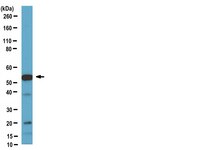The mechanism of release of P-TEFb and HEXIM1 from the 7SK snRNP by viral and cellular activators includes a conformational change in 7SK.
Krueger, BJ; Varzavand, K; Cooper, JJ; Price, DH
PloS one
5
e12335
2009
Kivonat megmutatása
The positive transcription elongation factor, P-TEFb, is required for the production of mRNAs, however the majority of the factor is present in the 7SK snRNP where it is inactivated by HEXIM1. Expression of HIV-1 Tat leads to release of P-TEFb and HEXIM1 from the 7SK snRNP in vivo, but the release mechanisms are unclear.We developed an in vitro P-TEFb release assay in which the 7SK snRNP immunoprecipitated from HeLa cell lysates using antibodies to LARP7 was incubated with potential release factors. We found that P-TEFb was directly released from the 7SK snRNP by HIV-1 Tat or the P-TEFb binding region of the cellular activator Brd4. Glycerol gradient sedimentation analysis was used to demonstrate that the same Brd4 protein transfected into HeLa cells caused the release of P-TEFb and HEXIM1 from the 7SK snRNP in vivo. Although HEXIM1 binds tightly to 7SK RNA in vitro, release of P-TEFb from the 7SK snRNP is accompanied by the loss of HEXIM1. Using a chemical modification method, we determined that concomitant with the release of HEXIM1, 7SK underwent a major conformational change that blocks re-association of HEXIM1.Given that promoter proximally paused polymerases are present on most human genes, understanding how activators recruit P-TEFb to those genes is critical. Our findings reveal that the two tested activators can extract P-TEFb from the 7SK snRNP. Importantly, we found that after P-TEFb is extracted a dramatic conformational change occurred in 7SK concomitant with the ejection of HEXIM1. Based on our findings, we hypothesize that reincorporation of HEXIM1 into the 7SK snRNP is likely the regulated step of reassembly of the 7SK snRNP containing P-TEFb. | Western Blotting | 20808803
 |









